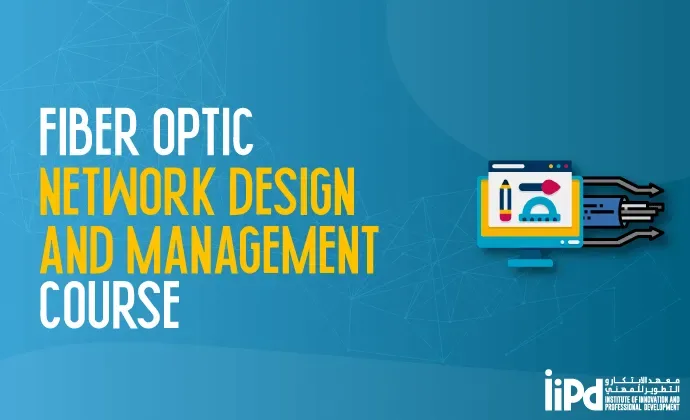
Course Details
Master Fiber Optic Network Design: From Fundamentals to Applications
This comprehensive Fiber Optic Network Design and Architecture course equips you with the skills to design, implement, and manage robust fiber optic networks across diverse applications. Through a blend of theoretical knowledge and practical exercises, you'll gain a thorough understanding of:
- Fiber Optic Fundamentals: Grasp the core principles of fiber optics, including light propagation, cable types, and transmission characteristics.
- Network Topologies: Explore various network topologies (e.g., star, bus, mesh) and master the selection of the most optimized configuration for specific applications.
- International Standards: Immerse yourself in understanding and applying industry-leading standards like TIA and ISO for compliant network design.
- Fiber Optic Specifications: Deepen your knowledge of fiber optic specifications, analyzing factors like core size, cladding diameter, and numerical aperture.
- Fiber Optic Cable Selection: Master the selection of appropriate fiber optic cables based on performance requirements and cost-effectiveness considerations.
- Network Component Selection: Learn to choose the right active components (e.g., transceivers, multiplexers) to ensure optimal network functionality.
- Fiber Optic Network Documentation: Gain the skills to prepare clear and comprehensive fiber optic network documentation for future reference and maintenance.
- Link Loss Budget Analysis and Calculation: Develop the ability to calculate and analyze link loss budgets, ensuring sufficient signal strength throughout the network.
- Bandwidth & Bit Rate Determination: Understand the relationship between bandwidth and bit rate, allowing you to determine the appropriate capacity for your network design.
- Advanced Installation Techniques: Explore the latest and most efficient techniques for installing fiber optic networks.
- High-Traffic Transmission Systems: Learn about the design considerations for handling high-volume traffic transmission over fiber optic networks.
- Real-World Applications: Gain valuable insights through case studies and practical examples of fiber optic network implementation across various sectors (e.g., telecommunications, enterprise, residential).
- Fiber-to-the-Home (FTTH) Design & Applications: Delve into the specific design principles and applications of FTTH networks, a rapidly growing technology.
Who Should Attend?
This course caters to a broad audience of professionals involved in the design, implementation, and management of fiber optic networks, including:
- Designers
- Network engineers
- Telecom engineers
- Presales engineers
- Project managers
- Contractors
- Consultants
Prerequisites:
- Fiber Optic Technician Course
Course Contents:
The course contents are thoughtfully curated to provide a comprehensive understanding of the subject. Beginning with foundational concepts, the curriculum progresses into specialized topics through engaging lectures, discussions, and practical exercises. This balanced approach between theory and application equips students with valuable skills for real-world success.
Fiber Optic Fundamentals
- Overview
- Advantages of Fiber Optic
- Fiber Optic vs. Copper
- Parameters explaining
- Fiber Optic Transmission Basics
Fiber Optic Types & Standards
- Single Mode
- Multi-Mode
- Plastic Fiber Optic
Fiber Optic Losses and Transmission Effects
- Insertion and Reflection Loss
- Splice Loss and Termination Loss
- dB & dBm
- Bending, Temperature, Humidity, and Pressure
Fiber Optic Design Overview
- Introduction to the Fiber Optic Design
- Who can design the fiber optic networks?
- Design Process
Fiber Optic Networks Topologies, Examples, and Applications
- Meaning of Topology
- Star Topology
- Ring Topology
- Bus Topology
- Mesh Topology
- Tree Topology
Fiber Optic International Standard
- TIA
- ISO
Fiber Optic Cable Specifications Studying
- Environmental Specifications
- Mechanical Specifications
- Optical Specifications
How to Choose the Components?
- Choosing Fiber Types
- Indoor cables (riser & Plenum)
- Outdoor cable (Armored & Heavy Duty)
- Hardware and Accessories
- Choosing Installation Techniques
- Choosing Civil Materials, Manholes, and Conduits
- NEC and IEC standards
Advanced Fiber Optic Cable Installation Techniques
- Cable blowing (air jetting)
- Cable Floating
- Modern Submarine Cabling
- HDD
- Micro Trenching
- Micro Ducting
- Mid-Span
Plant Link Loss Budget Analysis and Calculation
- Loss Types
- Total Loss Equation
- Loss Safe Factor
Transmission Equipments Power Budget Calculation
- Transmitter Power
- Receiver Sensitivity
- Power Budget Calculation
Fiber Optic Active Components
- Fiber / Ethernet converters
- Fiber / Coaxial converters
- Fiber / serial converters
- SM / MM converters
- Industrial Switches
- Cisco SFP selection guide
MM Fiber Bite Rate Calculation
- MM OM1, OM2, OM3 and OM4 Bandwidth
- MM Fiber and Bite Rate Calculation
Introduction to Optical Multiplexing
- Introduction to multiplexing
- FDM and TDM
- WDM
- CWDM
- DWDM
- OADM
Fiber Optic Project
- Site Survey
- Right of the Way
- Project Costing
- Network Planning
- Network Installation
- Dark Fiber
Fiber Optic Plant Documentations
- Network Drawing
- Preparing Bill of Quantities
- Installation Time Schedule
- Testing Sheets format
- Labeling
- As built and Plant Handover
General Fiber Optic Applications and Studying Cases
- Power Application- SCADA system
- Oil Application - Oil pipeline
- Telecom Application - DWDM
- Military Application - Radar
- IT Application - 10G WAN
- Security Application - CCTV
- Media Application - SAN
FTTX (Fiber To The X)
- What is the FTTX?
- FTTX vs. Traditional Systems
- FTTO, FTTB, FTTN & FTTH
- Fiber Splitters
- Splitter Loss
- FTTH Design Guide
Network Management
- Project management
- Operation support
- Network Analytics
- Managing troubleshooting
- Review and Quiz
By enrolling in this course at IIPD Global, participants will gain the expertise needed to navigate the complexities of fiber optic networks and effectively manage their design and implementation. Whether you are a seasoned professional aiming to enhance your skills or an aspiring specialist seeking to enter this thriving field, this course is designed to cater to diverse learning needs.
Don't miss out on this chance to elevate your career prospects and contribute to the ever-evolving world of telecommunications. Enroll now at IIPD Global and embark on a journey toward excellence in fiber optic network design and management. Your future in this dynamic industry awaits.








